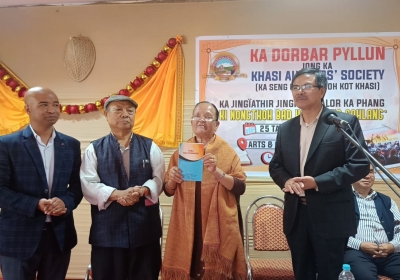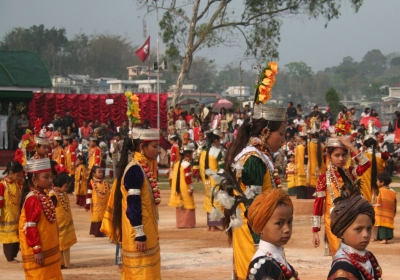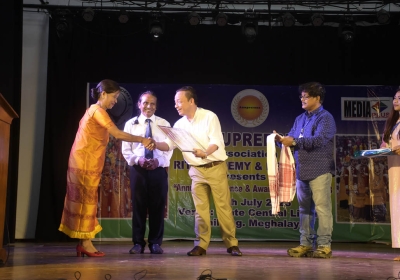Khasi Films of Meghalaya

Film is a communication medium that has the broad appeal and response to the public at large and to a group of individuals at different levels of intellectual discourse on wide ranging issues of education, commerce, documentation, research, archive, dissemination of information and above all entertainment and usually without any language barrier. A good film director conveys his or her message to viewers through visuals with limited oral narration. In this century, film production develops very fast in the world. With the emergence of digital technology and the advancement of information technology audio visual communication enters at every nook and corner of the world. India tops in the world in film production, even as Hollywood movies dominated the globe. However, every territory of every other country across the globe had their share of film production, as much as the Khasi region does in a small way. The first ever notice of filming in the Khasi region was amateur filming of places and events in the 1930s by someone from the western countries, as provided by the web portal ‘Raiot’. Perhaps, because of the struggle against British colonialism, there was a break for more than a decade until Indian Independence in 1947. There were mentions of 8mm movies in certain quarters, primarily of the Shadsuk Mynsiem at Weiking, Jaiaw, Pomblang Ceremony and Festival popularly known as Nongkrem Festival at Smit and some archive materials with the Roman Catholic church, which sufficient details could not be derived. Thereafter, the most significant film on the Khasi culture was in 1964, when Dr Bhupen Hazarika made his fourth Assamese film ‘Pratidhwani’, based on Khasi folklore ‘Manik Raitong’. He composed the lyric “Lieng Makaw” that described the traditional Khasi jainsem as a piece of cloth woven from lightning, an identity of the matrilineal society and contains several Khasi words predominantly ‘Khublei Shibun’.
The tribal folklore and natural landscape of the North Eastern region had attracted few Indian and several regional films production through the years and the most popular venture is the Bollywood movie in 1972 by Guru Dutt ‘Yeh Gulistan Hamara’, which was shot almost entirely in the Khasi territory with few locations in Assam and Arunachal Pradesh. Several Assamese films also are being shot in Meghalaya, with negligible involvement of any Khasi elements.
The first ever Shillong Film Society founded in 1962 is one of the oldest film appreciation organisations in India. It is more of an elite club with selected membership and exclusive activities, founded by Padum Barua and Md Sadullah. The austere and refined Bengal cinema, particularly the films of Satyajit Ray and Ritwig Ghatak have had significant impact and adequate emphasis was also bestowed upon the emerging Assamese films at that time. The Khasi cultural milieu explored by Bhupen Hazarika in 1964 did not have any subsequent outcome in cinematic expression. The political situation of that time could be instrumental in the negligence of the overall Khasi socio-cultural development. Prior to the Hill State movement there were some outstanding Khasi performing artistes and personnel in the creative arts fields, like Peace Roy Pariat, Rash Mohon Roy, Earnest Sweet Fred Pariat, Berrywell Kyndiah, Bashai Rai Dohling, Dr Hamlet Bareh, Listrimai Syiemlieh, Evelyn Nohra Rani Shullai, E Brektist R Wanswett, Webster Davies Jyrwa, Dr. Helen Giri, B Chedrack Jyrwa, Chosterfield Khongwir, John Sentar Shangpliang, O L Marbaniang and few others, but were not involved in such groups due to various factors. The imposition of Assamese language as lingua franca in the region is one major hindrance to every tribal cultural exposition. Likewise there are few eminent film personalities that emerged from Shillong like Victor Banerjee, Utpal Dutt, Sher Choudhury that we know of. One of the finest musicologists, E B R Wanswett lent his music for BBC documentary on Sohra monsoon. One of the most outstanding film personalities from Meghalaya is Mr Bashai Rai Dohling. He was among the first animation artists of India under the Film Division, Ministry of Information and Broadcasting. He was instrumental in the making of an animation film ‘Synthesis’ with A R Sen which bagged the National Award for Best Animation Film in 1974. In my humble opinion I would consider him as the pioneer of animation film in India.
In 1981, Ka Synjuk Ri ki Laiphew Syiem was made by Dr Hamlet Bareh Ngapkynta's and became the first ever proper film in Khasi. Subsequently, in 1984 Mr Rishan Rapsang produced the film Manik Raitong, which is the first ever CinemaScope color film in the Khasi language directed by Ardhendu Bhattacharya. The film bagged the Indian Panorama Award at the 32nd National Film Awards 1985 and the Appheia Award at Tokyo Film Festival, Japan. Till then cinema production in celluloid film was a cumbersome and expensive affair and there is hardly any Khasi film production, except for the low budget film ‘I Mei Jongnga’ the 8mm film by B Chedrack Jyrwa, directed by John Sentar Shangpliang and cinematography by O Linus Marbañiang.
With the emergence of the video technology and the onset of television broadcast through Doordarshan Kendra, there was a sudden upsurge of video films on VHS format, even as the ‘U’ matic broadcast format was the least eligible format for Doordarshan. Some of the worthwhile amateur filmmakers on VHS are Mr. Sneng Sing Tariang, Mr. Kitbor W Nongrum, Mr. Rana Kharkongor, Mrs Phidalia Toi, Mr. Rajesh Khongthaw, Mr. Amir Pariat and a few others. The proper production of Khasi films in Doordarshan NE Production Centre was ‘Ka Nong’ produced by Webster Davies Jyrwa and directed by Kuloda Kumar Bhattacharya.
As a visual artist I was drawn towards motion pictures and in 1987, I made an experimental film ‘Haba Don Ka Mon’ and subsequently ‘Wei La Kut Jingmut’ and was not fully satisfied and realised the limitation of proper production of films on VHS format. The State Government has consecutively initiated certain efforts to promote film production, some film enthusiasts came forward and the Meghalaya Filmmakers' Guild was formed on 12 September 1989. The Directorate of Information and Public Relations, Meghalaya convened the meeting between Shri Jagat Murari, Secretary, Information and Broadcasting and former Director, Film and Television Institute of India, Pune and the local filmmakers of Meghalaya on 6th May 1988. However, the efforts did not bear any positive results and mushrooming of sub-standard production prevailed without proper professional involvement in production, and thereby many promising and talented persons were frustrated. Moreover, in the subsequent years the Indian Panorama film festivals were held in the State displaying superficial and extravagant glamour without substance; and the fly-by-night financial swindling and the heights of mockery for the State government is the alleged financial grant of a whooping two crore rupees for the Rock On- 2 Bollywood movie.
In 1992 I decided to venture with ‘U’matic format and the maiden attempt was the documentary film on the cremation ceremony of Lyngngam people. It is the documentation on the endangered folk custom believed to be the last to have been performed according to the ancient belief system. Simultaneously, I was associated with Dr. Mazel Ampareen Lyngdoh for few State Government projects and with World View Club, a cable network for independent productions. The musical video ‘Christmas in the Hills’ produced by World View Club in collaboration with Spectrum Audio-Visual in 1992 was an instant hit at Doordarshan, which was broadcast at prime national channels. On the other hand, the documentary film ‘Ka Phor Sorat’ was first shown at Tripura during the North East Film Festival 1994. Soon after, under the initiative of Dr Kynsai M Warjri of Education Department and Kynpham Sing Nongkynrih of English Department North Eastern Hill University, the film was nominated at the Film South Asia at Kathmandu in 1997 and the 6th International Short Film Festival, Dhaka in 1999, beside other film festivals in the country.
Consequently, Doordarshan Shillong Kendra introduced the Commissioned Programmes and several producers and directors were able to make films in broadcast format, that is ‘U’matic High Band and Betacam. Coincidentally, St Anthony’s Mass Communication and Video Production Department also started in 1995 and many Mass Communication graduates were empanelled with Doordarshan and few of them have made a mark in the country. Among the new generation of prominent filmmakers are Wanphrang K Diengdoh and Nicholas Kharkongor. Within a short span Wanphrang K Diengdoh have had some accolades for some of his movies with the latest sensation ‘Lorni- the Flaneur’, while Nicholas Kharkongor’s Axone is well received in the country; while noted independent filmmaker Pradeep Kurbah emerged as the most established filmmaker with Indian Panorama Awards for his films Ri in 2013, Onaatah in 2016 and Iewduh in 2019 including few awards at the international circuit. Few films based on folklore, research on social issues with significant contents and without emphasis on commercial viability are B B Lyngdoh: The Statesman by Desmond Leslie Kharmawphlang, Nohkalikai and Diahmai by Mrs PhidaliaToi, Lamchwa by Mr. D R Michael Buam, whom he also published the book entitled Ngait’O, the comedy film Chakae by Riquoma Laloo and few others.
It is pertinent to mention about the film making premise in the State of Meghalaya and for the Garo segment, Mr Dominic Sangma is perhaps among the most important figures of Meghalaya film landscape. His film ‘Ma’ama’ received the Indian Panorama Award, Best Film at the Mumbai Academy of the Moving Image (MAMI) Mumbai Film Festival 2018, Best Cinematography and Best film at 22nd Shanghai International Film Festival, besides the selection for screening at the most prestigious global platform, the Cannes Film Festival, which is the great honour for the North Eastern region of India and the country as well. It may be recalled that the first ever Garo film ‘Nikjagringa’ was made by Akash Singh and Directed by Nabadal Kanti Deb in 1994.
With the inception of digital technology, several filmmakers have emerged in the state catering the category of glamour and entertainment with commercial motives. The prominent films are 9Lad by Commander Shangpliang, Pynngop by Emdor Suchiang and Jingmaham by Munich Production. Most of these commercial films are lacking in many aspects of production and potential for proper exposition, which drastically affect the quality of production. Nevertheless, the home grown initiative is more of enthusiasm and passion that the expectations of the masses are not properly achieved, which affects the professional output of the end product.Therefore, the local filmmakers felt the need for a proper approach to film production, in which some aspiring and enterprising personnel have partnered with established production houses from Assam and Manipur for various applied skills, particularly technical expertise. In a small way I am also concerned about the local scenario and made a decent attempt to make a feature film based on Khasi folklore ‘Tiewlarun’ and I hope that it will contribute to the betterment of film making in the State. As and when the pandemic Covid 19 winds up, the film entitled ‘Apot’ is slated to be released soon, and anticipate a favourable prospect.







